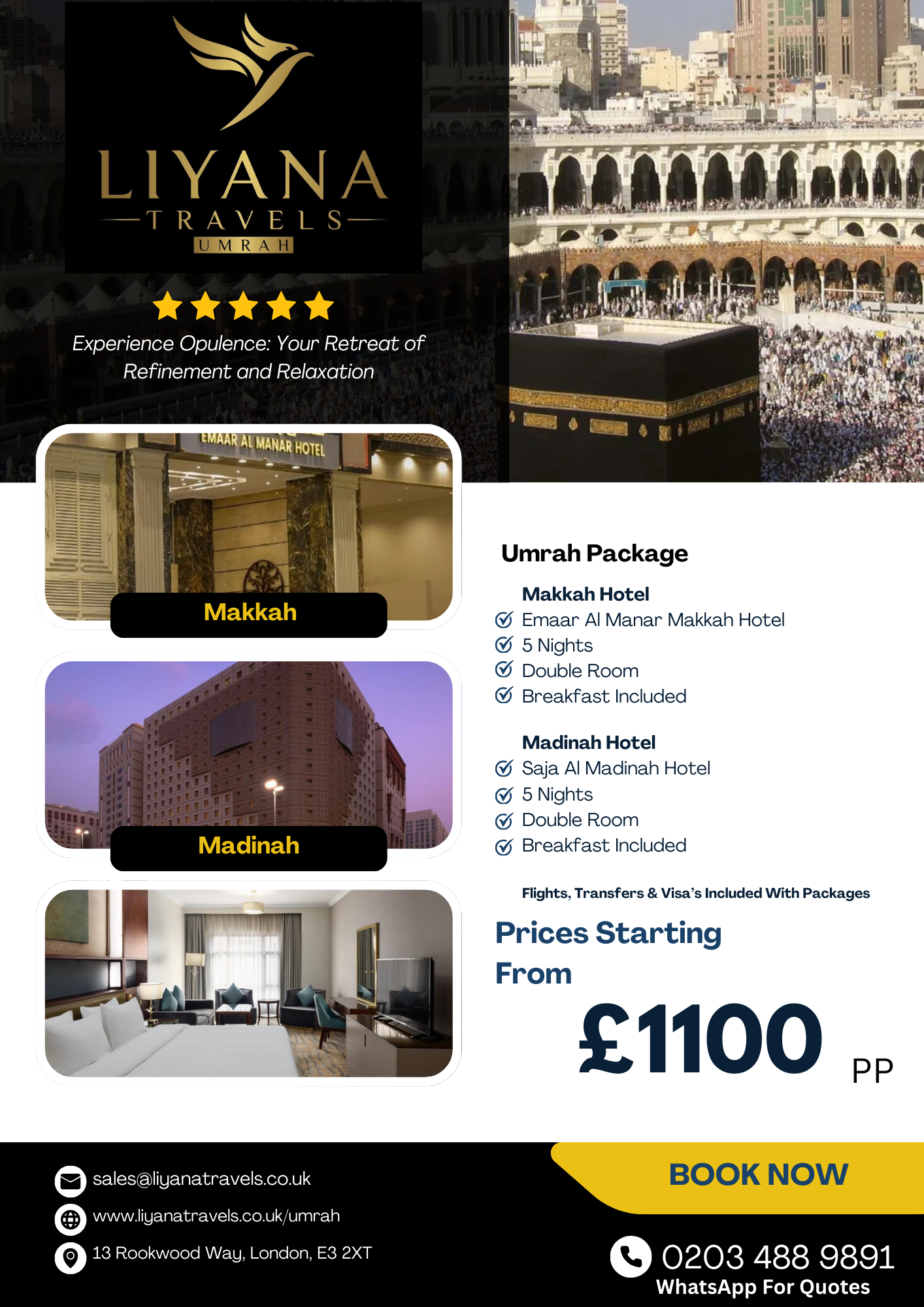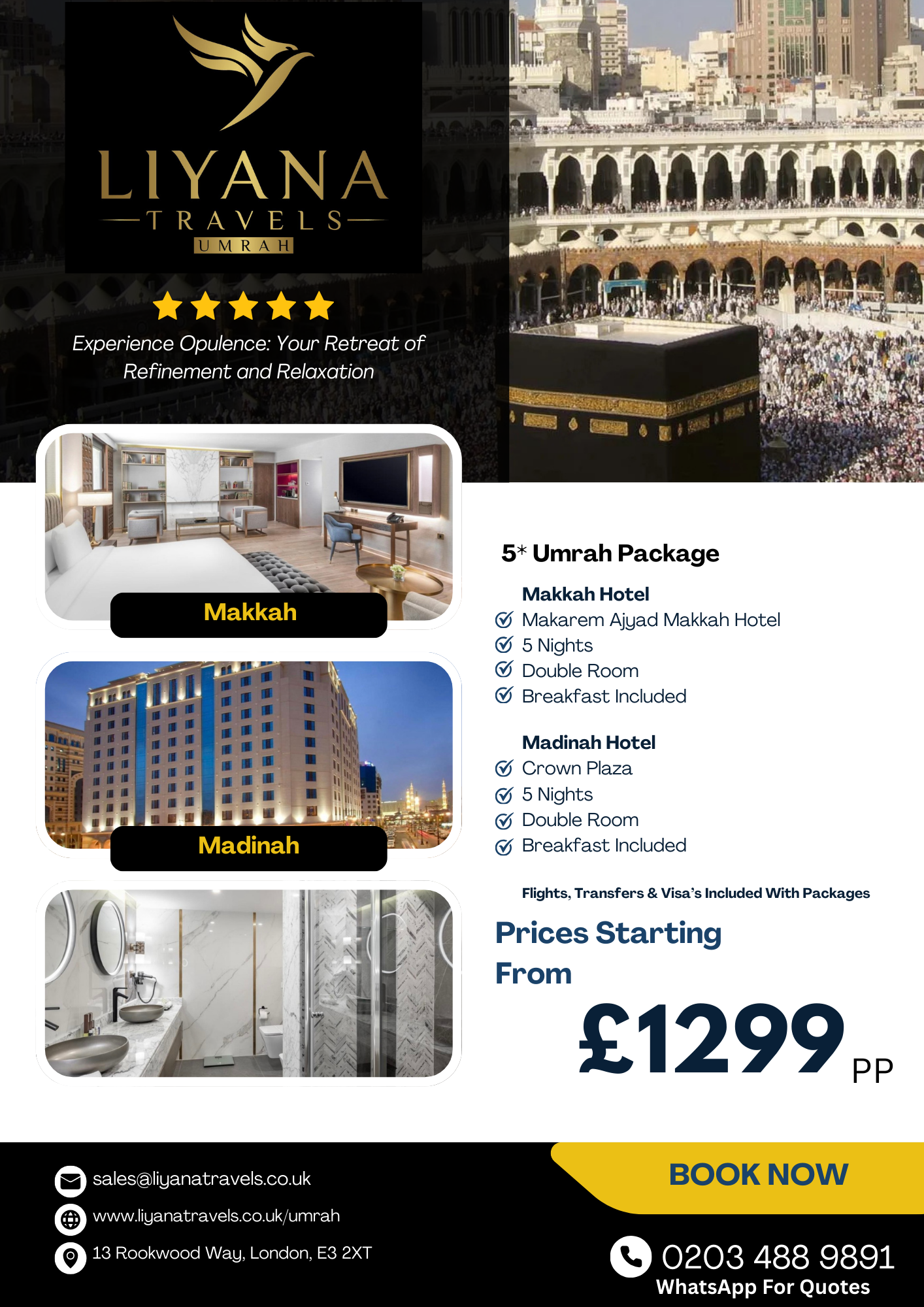Hajj and Umrah
Embark on Your Sacred Journey with Liyana Travels
Welcome! Embarking on the pilgrimage to Mecca and Medina is one of the most profound and spiritually rewarding journeys a Muslim can undertake. Whether you're preparing for the obligatory Hajj or the voluntary Umrah, these sacred rites offer a unique opportunity for reflection, purification, and connection with Allah (SWT).
At Liyana Travels, we understand the deep significance of this journey. We're here to guide you through every step, ensuring your pilgrimage is as smooth, comfortable, and spiritually fulfilling as possible. This guide provides essential information about Hajj and Umrah to help you prepare.
What is Hajj? The Pillar of Islam
Hajj (حَجّ) is the major Islamic pilgrimage to the holy city of Mecca in Saudi Arabia. It is one of the Five Pillars of Islam and is obligatory for all Muslims who are physically, mentally, and financially capable of undertaking the journey at least once in their lifetime.
- Timing: Hajj takes place during a specific time each year, in the last month of the Islamic lunar calendar, Dhul Hijjah (ذو الحجة), typically over five to six days.
- Significance: Hajj commemorates the devotion of Prophet Ibrahim (Abraham) and his family to Allah (SWT). It involves a series of detailed rituals performed in and around Mecca, including at Mina, Mount Arafat, and Muzdalifah.
- Key Rituals: These include entering a state of purity (Ihram), circling the Kaaba (Tawaf), walking between the hills of Safa and Marwah (Sa'i), standing vigil on the plains of Arafat (Wuquf), symbolic stoning of pillars representing Satan (Ramy al-Jamarat), and animal sacrifice (Qurbani/Hady), culminating in shaving or trimming the hair.
Hajj is a powerful symbol of unity, bringing together millions of Muslims from every corner of the globe, dressed simply in Ihram, standing equal before Allah (SWT).
What is Umrah? The Lesser Pilgrimage
Umrah (عُمْرَة), often called the 'lesser' or 'minor' pilgrimage, is a visit to the holy city of Mecca that involves specific acts of worship. Unlike Hajj, Umrah is not obligatory (though highly recommended - Sunnah Mu'akkadah) and can be performed at any time of the year, except during the specific days of Hajj.
- Timing: Can be performed year-round. Many choose to perform Umrah during Ramadan for increased blessings, or combine it with a Hajj journey (known as Hajj Tamattu' or Hajj Qiran).
- Significance: Umrah offers an opportunity to seek forgiveness, earn rewards, and refresh one's faith by visiting the sacred Kaaba.
- Key Rituals: Umrah involves fewer rituals than Hajj and can often be completed in a few hours. The core rites are:
- Entering the state of Ihram at or before the designated boundary (Miqat).
- Performing Tawaf (circling the Kaaba seven times).
- Performing Sa'i (walking seven times between Safa and Marwah).
- Shaving (Halq) or trimming (Taqsir) the hair to exit Ihram.
The holiest city in Islam, birthplace of Prophet Muhammad (PBUH).
- Masjid al-Haram: The Grand Mosque, which houses the Kaaba (الكعبة), the cube-shaped structure Muslims face during prayer (Qibla). Performing Tawaf around the Kaaba is central to both Hajj and Umrah.
- Safa and Marwah: Two small hills within the Masjid al-Haram complex where pilgrims perform Sa'i.
- Other Hajj Sites: Mina, Arafat, and Muzdalifah are key locations visited during the specific days of Hajj.
Mecca (Makkah Al-Mukarramah)
The second holiest city, where Prophet Muhammad (PBUH) migrated, established the Muslim community, and is buried.
- Masjid an-Nabawi: The Prophet's Mosque, containing his tomb, is a place of immense peace and spirituality. Praying in the Rawdah ash-Sharifah (a specific area within the mosque) is highly sought after.
Medina (Madinah Al-Munawwarah)
The Sacred Destinations: Mecca and Medina
Your pilgrimage centres around two of the holiest cities in Islam
Flights: Most international pilgrims fly into either:
- King Abdulaziz International Airport (JED) in Jeddah: The main gateway for Mecca, located about 75 km away.
- Prince Mohammad bin Abdulaziz International Airport (MED) in Medina: Convenient if starting your pilgrimage in Medina.
Getting to the Holy Cities
Visas: This is crucial. You cannot travel for Hajj or Umrah on a standard tourist visa or e-visa (though some nationalities like UK citizens may be able to perform Umrah on an e-visa or visa-on-arrival outside the Hajj season – always check current regulations).
Specific Hajj or Umrah visas are required.
- These visas must be obtained through government-approved Hajj and Umrah travel agents, like Liyana Travels. We handle the complex application process for you.
- Requirements typically include a passport valid for at least six months, passport photos, proof of vaccination (especially Meningitis ACWY, often COVID-19 and seasonal flu too – check latest Saudi Ministry of Health requirements), and for women, proof of Mahram relationship if applicable.
Many pilgrims choose a 'two-centre' trip, visiting both holy cities. The distance between Mecca and Medina is approximately 450 km. Several comfortable options exist for this journey:
Travelling Between Mecca and Medina (Two-Centre Pilgrimage)
- Haramain High-Speed Railway (HHR): The fastest and most popular option. Modern, comfortable trains connect Mecca, Jeddah, King Abdullah Economic City, and Medina. The journey between Mecca and Medina takes roughly 2.5 hours. Booking in advance is recommended, especially during peak seasons. Liyana Travels can arrange these tickets as part of your package.
- Buses: More economical options like SAPTCO buses are available. The journey takes significantly longer, typically 6-9 hours depending on traffic and stops.
- Private Taxis/Cars: Offer flexibility and privacy but are generally the most expensive option.
In Mecca: Staying as close as possible to Masjid al-Haram is highly recommended.
- Benefits: Easy access for the five daily prayers (especially Fajr), quick return for rest between rituals, immersion in the spiritual atmosphere.
- Prime Locations: Hotels within the Abraj Al Bait (Clock Tower) complex offer direct Haram views and access. The Jabal Omar development area also features many high-quality hotels within very close walking distance.
- Budget Options: Hotels slightly further away often provide shuttle services to the Haram during prayer times. Liyana Travels offers a range of hotels to suit various budgets, prioritising convenience.
Mecca (Makkah Al-Mukarramah)
In Medina: Proximity to Masjid an-Nabawi is key.
- Benefits: Enables easy attendance of prayers, visiting the Prophet's tomb, and spending time in the serene Rawdah.
- Prime Locations: Hotels in the central area (Markaziya) surrounding the mosque are ideal. Many offer views of the mosque grounds.
- Variety: Like Mecca, Medina offers hotels across different price points, many within comfortable walking distance.
Staying close allows you to maximise your time for worship and minimise travel fatigue, enhancing the spiritual focus of your trip.
Medina (Madinah Al-Munawwarah)
Where to Stay: Maximising Your Spiritual Experience
Your choice of accommodation significantly impacts your pilgrimage experience.
Top Packages


Why Choose Liyana Travels for Your Hajj or Umrah Journey?
Planning a pilgrimage can seem daunting, but it doesn't have to be. Liyana Travels specialises in crafting seamless, ATOL-protected Hajj and Umrah packages tailored to your needs. We provide:
- Expert Guidance: Navigating visa requirements, flights, and logistics.
- Quality Accommodation: Carefully selected hotels close to the Harams.
- Reliable Transport: Arranging comfortable transfers and inter-city travel.
- Peace of Mind: Allowing you to focus entirely on your spiritual journey.





